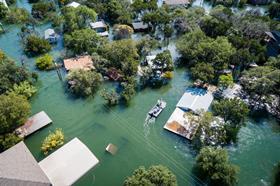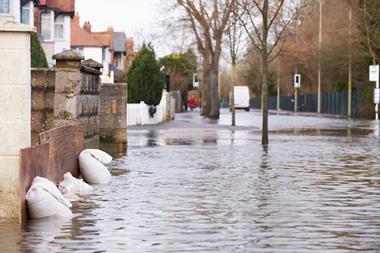Following the publication of the government’s Flood and Coastal Erosion Investment Plan last month, industry commentators explain what the report might mean for the insurance sector
There is “more to be done” by the insurance industry in conjunction with the UK government’s plan to invest £5.2bn over six years to better protect UK businesses and homes from flooding and coastal erosion.
This is according to Zurich’s policy and public affairs manager Joseph Priestley, who highlighted that any investment by the government to tackle flood risks needs to be part of a wider portfolio of solutions.
He explained that “more needs to be done to ensure local, property-specific resilience measures work alongside larger scale flood infrastructure”.
For example, to provide communities with an ongoing flood risk reduction strategy, Priestley said solutions need to include improved communication of flood risk, the use of sustainable drainage systems and natural flood management techniques, such as restoring bends in rivers, changing the way land is managed so soil can absorb more water and creating saltmarshes on the coast to absorb wave energy.
Priestley continued: “With the value of assets - including homes, businesses and municipal structures - increasing and uncertain weather patterns due to climate change, more needs to be done to ensure local, property-specific resilience measures work alongside larger scale flood infrastructure.

“In communities where flood risk and poverty levels are high, the government should use its Property Flood Resilience Roadmap to ensure that its flood resilience grants are available up front.
“Ministers should ensure the grants are available throughout the year, so that people can take proactive steps to protect their homes and businesses.”
These grants of up to £5,000, introduced by the government, were created to help make properties more resilient to future flooding after severe flood events took place in November 2019 - this could include, for example, paying to install flood doors or raising electrics from ground level.
The scheme was extended last September to accommodate applications from eligible communities following Storms Ciara and Dennis in February 2020.
These grants are only available after a flooding event, however.
Ambitious but welcome
Within the government’s Flood and Coastal Erosion Investment Plan, published last month, more than £860m is ringfenced to be invested in over 1,000 flood alleviation schemes.
John Alexander, managing director at environmental consultancy Aquobex, said that although this proposal is an “ambitious” initiative to deliver, it is also “a very welcomed one” that should “help the country to avoid the current pitfalls that occur due to the current ‘start-stop’ approach to flood mitigation”.
He said: “There are still millions of homes around the UK that need to be protected, so this committed spending programme will bring greater certainty and continuity to affected households and to the flood protection industries supplying these schemes.”
The focus on planning permission is also “most welcome”, Alexander continued. He explained: “Most welcome though is the tighter restrictions on planning permission for new builds because we need to reduce the number of homes at risk, rather than increase them.”
James Dalton, director of general insurance policy at the ABI, agreed: “The government needs to provide an adequate, long-term investment programme to build new - and maintain existing - flood defences, whilst ensuring that the planning process prevents inappropriate new developments in areas at flood risk.”

The ‘big issue’
Another “big issue” is how to remedy surface flooding, noted Alexander.
On 29 July 2021, the Department for Environment, Food and Rural Affairs (Defra) published an update on its 2018 action plan on surface water management.
According to its report, surface flooding is the most widespread form of flooding in England, with around 3.2 million properties at risk.
Alexander explained that Defra’s report is of “equal importance” to the government’s investment plan because it maps out how local authorities and non-departmental public body the Environment Agency will work better together.
But, how this work ”is being funded is still not clear”, Alexander added.
Insurance Times approached Defra for further comment, but it declined.
Caring for flood victims
Meanwhile, to better support customers, insurers can invest in Flood Re’s ’Build Back Better’ proposal, which was also listed in the Flood and Coastal Erosion Investment Plan – this includes insurers paying an additional amount for the installation of property flood resilience measures, such as air brick covers, flood doors and the use of flood resistant plasterboard, when repairing flood damaged buildings.
If installed, insureds can then benefit from discounted insurance premiums due to a decreased risk of flooding.
Alexander said that “enthusiasm” for Flood Re’s latest proposition is “positive”.
He continued: “Rather than current insurance policies with like-for-like replacements after an event, these insurance policy changes will improve a property by allowing insurers to pay additional amounts for property resilience measures, such as flood barriers or doors, so recovering from a flood is much quicker and cheaper.”
Moving forward, Dalton said: “Insurers will continue to support their customers who have been flooded, have committed to developing a signposting service for those who find it challenging to obtain flood insurance and remain committed to doing all we can, in partnership with the UK government and the devolved administrations, to ensure that increased flood risk is appropriately managed.”
Echoing Dalton, Karl Parr, technical claims services director at Axa UK, added: “Flooding is the biggest natural threat facing the UK and recent events across mainland Europe remind us all about the devastating impact flooding can have on lives and communities.
“Axa is committed to playing its part by continuing to work with the UK government, the devolved administrations and industry counterparts to ensure that flood risk is appropriately managed and flood insurance is accessible for all those that need it.”
Hosted by comedian and actor Tom Allen, 34 Gold, 23 Silver and 22 Bronze awards were handed out across an amazing 34 categories recognising brilliance and innovation right across the breadth of UK general insurance.





















































No comments yet